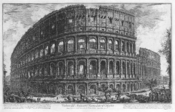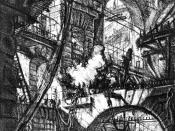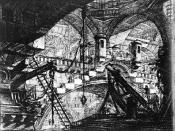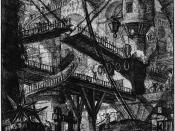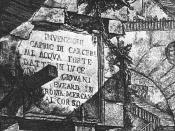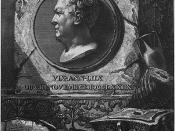Carceri D'Invenzione - print 11, second edition This intaglio print was made by Giovanni Battista Piranesi in the 1760's. It was the eleventh in a series of fourteen, entitled 'Carceri D'invenzione', or 'Prison of Creation'. Piranesi had much architectural influence, his father being a stonemason and brother an architect. The prison scene was a relatively common subject in surviving designs for eighteenth century stage sets. Examples of this can be found in the drawings of Filippo Juvarra, whose designs for Cardinal Ottoboni's theatre were a source of particular inspiration for Piranesi. The actual purpose behind this etching, and in fact the series, is not precisely know. The events that occurred in Rome in the 1700's do not give us much of an insight. However, it has been written in numerous books that the Carceri was a product of opium-induced hallucinations. It has also been suggested that Piranesi's inspiration was previous Roman art itself.
Roman art and architecture had a profound impact not only on the succeeding art of the Middle Ages, but on this Renaissance and baroque period as well. John Welton-Ely, in The Mind and the Art of Giovanni Battista Piranesi, went one step further in suggesting the Carceri was ...a gesture of defiance to the partons and architects of Rome who had failed to measure up to the creative possibilities suggested by the 'speaking ruins' surrounding them.
This particular print is an excellent example of the etching method. It represents an intensely private work, far ahead of its time in the usage of dramatic design elements. The most relied on element is that of perspective. The walls and stairs are gigantic in comparison to the tiny figures on them. This illustrates Piranesi's personal admiration for the statuesque beauty of the Roman buildings. Another aspect of perspective is the three dimensional appearance of the piece. This also flows into the element of tone in that the further back the walls get, the lighter they are etched. The tone has a dramatic effect on the overall piece. It is very detailed, giving depth, and seems to accentuate the idea of a prison in its seemingly dirty appearance. The line of the work is also an important aspect. It is rather expressive and definite, which outlines the architectural nature of Piranesi's work. The combination of the main design elements of tone, line and perspective, give an intensely effective overall appeal. It is doubtful that the ruins of Rome will ever again be so emotionally and ingeniously represented.
